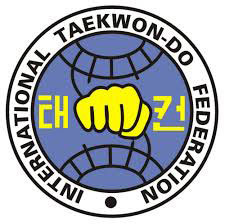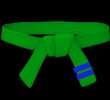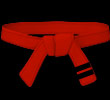Taekwondo 태권도Taekwondo Preschool
Promotion from one geup to the next can proceed rapidly in some schools, since schools often allow geup promotions every two, three, or four months. Students of geup rank learn the most basic techniques first, and then move on to more advanced techniques as they approach first dan. Many of the older and more traditional schools often take longer to allow students to test for higher ranks than newer, more contemporary schools, as they may not have the required testing intervals. View Taekwondo belt levels »

International Taekwondo Federation (ITF) Tul Forms
Patterns, tul or teul (틀) in Korean, originally called hyeong (형), form an important aspect of training in Taekwon-Do. They are equivalent to the kata in karate.
The majority of the patterns (except Yul-Gok, Ul-Ji and Tong-Il) start with a defensive move, which emphasizes taekwon-do's defensive nature. All of the patterns start and end at the same location. This ensures that the practitioners' stances are the correct length, width, and in the proper direction.
There are 24 patterns in the official ITF syllabus; this is symbolic of the 24 hours in a day. One additional pattern, Ko-Dang (or Go-Dang), was retired/replaced by Juche in 1986 by General Choi Hong Hi. Ko-Dang and Juche are similar, and some Taekwon-do organizations have renamed Juche to Ko-Dang though most perform the newer pattern. The names of these patterns typically refer either to events in Korean history or to important people in Korean history. Elements of the patterns may also be historical references, such as the number of moves, the diagram, the way the pattern ends, and so on.
( 10th geup ) 
4-Direction |
( 10th geup ) 
4-Direction |
Cheon-Ji ( 9th geup ) 
천지 / 天地 |
Dan-Gun ( 8th geup ) 
단군 / 檀君 |
Do-San ( 7th geup ) 
도산 / 島山 |
Won-Hyo ( 6th geup ) 
원효 / 元曉 |
Yul-Gok ( 5th geup ) 
율곡 / 栗谷 |
Joong-Gun ( 4th geup ) 
중근 / 重根 |
Toi-Gye ( 3rd geup ) 
퇴계 / 退溪 |
Hwa-Rang ( 2nd geup ) 
화랑 / 花郎 |
Chung-Mu ( 1st geup ) 
충무 / 忠武 |
Gwang-Gae ( 1st dan ) 
광개 / 廣開 |
Po-Eun ( 1st dan ) 
포은 / 圃隱 |
Gye-Baek ( 1st dan ) 
계백 / 階伯 |
Eui-Am ( 2nd dan ) 
의암 / 義菴 |
Chung-Jang ( 2nd dan ) 
충장 / 忠壯 |
Juche ( 2nd dan ) 
주체 / 主體 |
Sam-Il ( 3rd dan ) 
삼일 / 三一 |
Yu-Sin ( 3rd dan ) 
유신 / 庾信 |
Choe-Yeong ( 3rd dan ) 
최영 / 崔榮 |
Yeon-Gae ( 4th dan ) 
연개 / 淵蓋 |
Eul-ji ( 4th dan ) 
을지 / 乙支 |
Mun-Mu ( 4th dan ) 
문무 / 文武 |
Seo-San ( 5th dan ) 
서산 / 西山 |
Se-Jong ( 5th dan ) 
세종 / 世宗 |
Tong-Il ( 6th dan ) 
통일 / 統一 |

International Taekwondo Federation (ITF) Tul Forms
Patterns (teul) are performed in accordance with "The Encyclopedia of Taekwon-Do" in 15 volumes written by General Choi Hong Hi, the latest edition being from 1999 (later editions have been published, but the 1999 editions were the last General Choi Hong Hi was directly involved with). This comprehensive work contains 15 volumes with volumes 8 through 15 dedicated to the 24 patterns and containing descriptions of the pattern movements as well as pictures showing possible applications of some of the movements. For more information about the organization View International Taekwondo Federation (ITF) »
There is also the book entitled "The Korean Art of Self Defense" (the 1999 edition, the latest used by ITF under Grandmaster Tran Trieu Quan and ITF under Grandmaster Choi, or the 2004 edition, the latest used by ITF under Chang Ung), also known as the Condensed Encyclopedia, written by General Choi Hong Hi. This is a single condensed encyclopedia of approximately 770 pages with a section dedicated to the 24 patterns.
There are also three fundamental exercises, named Saju-Jirugi (Four Direction Punch), Saju-Makgi (Four Direction Block) and Saju Tulgi (Four Direction Thrust). Saju-Jirugi and Saju-Makgi are basic defence exercises taught to beginners of the martial art. Saju Tulgi is less well known and is generally taught to 2nd geup students just prior to Hwa-Rang. Saju Tulgi is not presented in the Condensed Encyclopedia but is present in the 15 Volume Encyclopedia (see: Volume 10, page 122).
The pattern names below are shown with Revised Romanization spellings; however, the traditional spellings are shown in parentheses if they vary from the modern standard, since those patterns have long been known with those spellings.

International Taekwondo Federation (ITF) Tul Forms
WHITE BELT FORMS

Saju-Jireugi ( 10th geup )
- Pattern Map Diagram
- White Belt
In ITF style, this is one of the first patterns you will learn when you start at white belt level. Saju-Jireugi is four direction punch. You will learn the basic foundations of poomse such as Low Block, Middle Punch, and Walking Stance.

Saju-Makgi ( 10th geup )
- Pattern Map Diagram
- White Belt
In ITF style, this is one of the first patterns you will learn when you start at white belt level. Saju-Makgi is four direction block. You will learn the basic foundations of poomse such as Knifehand Low Block, Middle Inner Forearm Block, and Walking Stance.

International Taekwondo Federation (ITF) Tul Forms
COLOR BELT FORMS

Cheon-Ji ( 9th geup )
- Pattern Map Diagram
- 천지 / 天地 - 19 movements
- Yellow Stripe Belt
Literally, Cheon-Ji (or Chon-Ji) means "heaven and earth" and refers to the creation of the world or the beginning of human history, and thus is the initial pattern learned by the beginner. It consists of forearm low blocks and punches in the first part to represent earth, and inner forearm middle blocks and punches in the second part to denote heaven. It does not use any kicks. The cross shaped diagram represents the four elements of the universe : fire, water, air and earth.

Dan-Gun ( 8th geup )
- Pattern Map Diagram
- Dangun
- 단군 / 檀君 - 21 movements
- Yellow Belt
Dan-Gun is named after the holy Dangun, the legendary founder of Korea in 2333 BC. Unusually for a teul, all the punches in Dan-Gun are high section (at eye level), symbolizing Dangun scaling a mountain.

Do-San ( 7th geup )
- Pattern Map Diagram
- Ahn Chang-ho
- 도산 / 島山 - 24 movements
- Green Stripe Belt
Do-San is a pseudonym of the patriot Ahn Chang-ho (1876-1938). The 24 movements represent his entire life, which he devoted to furthering education in Korea and the Korean independence movement.

Won-Hyo ( 6th geup )
- Pattern Map Diagram
- Wonhyo
- 원효 / 元曉 - 28 movements
- Green Belt
This pattern is named after the noted monk Wonhyo who introduced Buddhism to the Silla Dynasty in the year 686 AD.

Yul-Gok ( 5th geup )
- Pattern Map Diagram
- Yi I (1536-1584)
- 율곡 / 栗谷 - 38 movements
- Blue Stripe Belt
Yul-Gok is a pseudonym of a great philosopher and scholar Yi I (1536-1584) nicknamed the "Confucius of Korea". The 38 movements of this pattern refer to his birthplace on 38-degree latitude and the diagram of the pattern represents scholar.

Joong-Gun ( 4th geup )
- Pattern Map Diagram
- Ahn Joong-Gun
- 중근 / 重根 - 32 movements
- Blue Belt
Jung-Geun (or Joong-Gun) is named after the patriot Ahn Joong-Gun who assassinated Itō Hirobumi, the first Japanese governor-general of Korea, known as the man who played the leading part in the Korea-Japan merger. There are 32 movements in this pattern to represent Mr Ahn's age when he was executed at Lui-Shung Prison in 1910.

Toi-Gye ( 3rd geup )
- Pattern Map Diagram
- Yi Hwang
- 퇴계 / 退溪 - 37 movements
- Red Stripe Belt
Toi-Gye is the pen name of the noted scholar Yi Hwang (16th century), an authority on neo-Confucianism. The 37 movements of the pattern refer to his birthplace on 37-degree latitude, the diagram represents "scholar" as in the Yul-Gok hyeong.

Hwa-Rang ( 2nd geup )
- Pattern Map Diagram
- 화랑 / 花郎 - 29 movements
- Red Belt
Hwa-Rang is named after the Hwarang youth group that originated under the Silla Dynasty roughly 1350 years ago. The group eventually became the driving force for the unification of the three Kingdoms of Korea. The 29 movements refer to the 29th infantry Division, where Taekwondo developed into maturity.

Chung-Mu ( 1st geup )
- Pattern Map Diagram
- 충무 / 忠武 - 30 movements
- Black Stripe Belt
Chung-Mu (or Choong-Moo) was the name given to the great Admiral Yi Sun-sin of the Yi Dynasty. He was reputed to have invented the first armored battleship (kobukson) in 1592, which is said to be the precursor of the present day submarine. The reason this pattern ends with a left hand attack is to symbolize his regrettable death having no chance to show his unrestrained potentiality checked by the forced reservation of his loyalty to the King.

International Taekwondo Federation (ITF) Tul Forms
BLACK BELT FORMS

Gwang-Gae (1st dan)
- Poomse Map Diagram
- 광개 / 廣開 - 39 movements
Gwang-Gae (or Kwang-Gae) is named after the famous Kwang-Gae-Toh-Wang, the 19th king of the Goguryeo Dynasty, who achieved the greatest territorial expansion including the greater part of Manchuria. The diagram of the form represents the expansion and recovery of lost territory. The 39 movements refer to the first two figures of 391AD, the year he came to the throne.

Po-Eun (1st dan)
- Poomse Map Diagram
- 포은 / 圃隱 - 36 movements
Po Eun is the pseudonym of a loyal subject Jeong Mongju who was a distinguished scholar of neo-Confucianism during the Goryeo Dynasty. His poem "I would not serve a second master though I might be crucified a hundred times" is known to every Korean. The diagram, which is simply a straight line represents his unerring loyalty to the king and his country.

Gye-Baek (1st dan)
- Poomse Map Diagram
- 계백 / 階伯 - 44 movements
The Gye-Baek (or Gae-Baek) hyeong has 44 Movements. Gae-Baek is named after Gyebaek, a great general in the Baekje Dynasty. The diagram represents his severe and strict military discipline.

Eui-Am (2nd dan)
- Poomse Map Diagram
- 의암 / 義菴 - 45 movements
Eui-Am is the pseudonym of Son Byong Hi, leader of the Korean independence movement on March 1, 1919. The 45 movements refer to his age when he changed the name of his religion from Dong Hak (oriental learning) to Chondogyo (Heavenly Way Religion) in 1905. The diagram represents his indomitable spirit, displayed while dedicating himself to the prosperity of his nation.

Chung-Jang (2nd dan)
- Poomse Map Diagram
- 충장 / 忠壯 - 52 movements
Chung-Jang (or Choong-Jang) is the pseudonym given to General Kim Duk Ryang who lived during the Yi Dynasty, 14th century. This pattern ends with a left hand attack to symbolize the tragedy of his death at 27 in prison before he was able to reach full maturity.

Juche (2nd dan)
- Poomse Map Diagram
- 주체 / 主體 - 45 movements
The Juche hyeong has 45 movements. Juche is a philosophical idea that man is the master of everything and decides everything. In other words, the idea that man is that master of the world and his own destiny. It is said that this idea was rooted in Baekdu Mountain, which symbolize the spirit of the Korean people. The diagram represents Baekdu Mountain, which is the highest mountain in Korea.

Sam-Il (3rd dan)
- Poomse Map Diagram
- 삼일 / 三一 - 33 movements
Sam-Il name refers to the historic March 1st Movement, the biggest nation-wide Korean independence movement against the imperial Japan in 1919. The 33 movements in the pattern represent for the 33 patriots who planned the movement.

Yu-Sin (3rd dan)
Yu-Sin (or Yoo-Sin) is named after General Kim Yu-Sin, a commanding general during the Silla Dynasty who played an important role in the merger of Goguryeo and Baekje by Silla. The 68 movements refer to the last two figures of 668 AD the year the three kingdoms were unified. The ready posture signifies a sword drawn to the right rather than the left side, symbolizing Yoo Sin's mistake of following his king's orders to fight with foreign forces (Tang Dynasty of China) against his own people (Goguryeo and Baik-je).

Choe-Yeong (3rd dan)
- Poomse Map Diagram
- 최영 / 崔榮 - 46 movements
Choe-Yeong (or Choi-Yong) is named after General Choe Yong, Premier and Commander-in Chief of the armed forces during the 14th century Goryeo Dynasty. Choi Yong was greatly respected for his loyalty, patriotism, and humility. He was executed by subordinate commanders headed by General Yi Seonggye, who later became the first king of the Joseon Dynasty.
Yeon-Gae (4th dan)
- Poomse Map Diagram
- 연개 / 淵蓋 - 49 movements
Yeon-Gae (or Yon-Gae) is named after the famous general Yon Gae Somoon during the Goguryeo Dynasty. He defended Goguryeo from the aggression of the Tang Dynasty by destroying nearly 300,000 of their troops at Ansi Sung. (This pattern normally resides between Choi Yong and Se-Jong)
Eul-ji (4th dan)
- Poomse Map Diagram
- 을지 / 乙支 - 42 movements
Eul-Ji (or Ul-Ji) is named after general Eulji Mundeok who successfully defended Goguryeo against a Sui invasion force of over one million soldiers led by Yang Je in 612AD. By employing hit and run guerilla tactics, he was able to destroy the majority of the force. The diagram of the hyeong represents his surname. The 42 movements represent the author's age when he designed the pattern.
Mun-Mu (4th dan)
- Poomse Map Diagram
- 문무 / 文武 - 61 movements
Mun-Mu (or Moon-Moo) honors King Munmu, the 30th king of the Silla Dynasty, who completed the unification of the three kingdoms (Goguryeo, Baik-je, Silla). His body was buried near Dae Wang Am (Great King's Rock). According to his will, the body was placed in the sea "Where my soul shall forever defend my land against the Japanese". The 61 movements in this pattern symbolize the last two figures of 661 AD when Munmu came to the throne. (This pattern normally resides between Choi Yong and Sea-Jong)
Seo-San (5th dan)
- Poomse Map Diagram
- 서산 / 西山 - 72 movements
Seo-San (or So-San) is the pseudonym of the great monk Choi Hyon Ung during the Joseon Dynasty. The 72 movements refer to his age when he organized a corps of monk soldiers with the assistance of his pupil Sa Myung Dang. The monk soldiers helped repulse the Japanese who overran most of the Korean peninsula in 1592 during the Imjin War. (This pattern normally resides between Choi Yong and Sea-Jong) Seo-San is the longest of all Taekwon-do patterns.
Se-Jong (5th dan)
- Poomse Map Diagram
- 세종 / 世宗 - 24 movements
This pattern is named after Se-Jong who was the 4th King of the Yi Dynasty. He was known for his many great achievements in domestic and foreign affairs, diplomacy, scientific advancements, defense matters and culture. His most remarkable achievement was his invention of "Hangeul", the Korean Alphabet. The 24 movements of this pattern represent the 24 letters of the "Hangeul".
Tong-Il (6th dan)
- Poomse Map Diagram
- 통일 / 統一 - 56 movements
Tong-Il means "unification" which is the ultimate goal of all Koreans. Korea used to be one country, but was divided into North and South Korea in 1945 by the ideological conflict between the USSR and the USA after World War II. Yon Mu Sun, the diagram of this pattern symbolizes the North and South becoming one.
General qualities that judges look for in any taekwondo practitioner include proper breathing technique and body control. The diaphragm must be engaged in deep breathing, shallow breathing concentrated in the upper abdomen results in raised shoulders and stressed muscles. The muscles of the body should be lightly relaxed in order to perform the pattern with fluidity, speed and grace. Muscles should only be tensed at the moment of imaginary impact in order to commute maximum power to any individual taekwondo technique. For more information View Key Points »
RESOURCES
This article uses material from the Wikipedia articles "International Taekwon-Do Federation" and "Hyeong", which is released under the Creative Commons Attribution-Share-Alike License 3.0.










